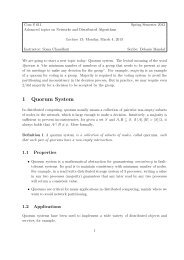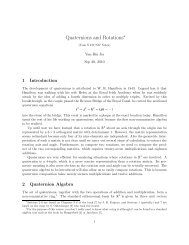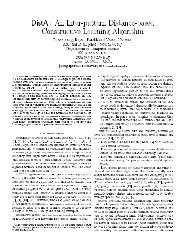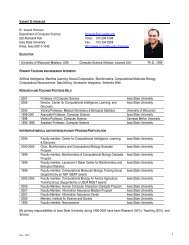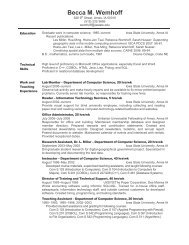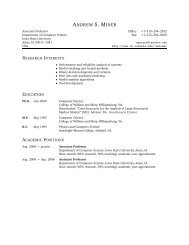Geocasting in Mobile Ad Hoc Networks: Location-Based ... - CiteSeerX
Geocasting in Mobile Ad Hoc Networks: Location-Based ... - CiteSeerX
Geocasting in Mobile Ad Hoc Networks: Location-Based ... - CiteSeerX
Create successful ePaper yourself
Turn your PDF publications into a flip-book with our unique Google optimized e-Paper software.
with one modification. Node S def<strong>in</strong>es (implicitly or explicitly)<br />
a “Forward<strong>in</strong>g Zone” for the multicast data packet. A<br />
node forwards the multicast packet only if it belongs to the<br />
forward<strong>in</strong>g zone (unlike the multicast flood<strong>in</strong>g algorithm <strong>in</strong><br />
Section 3.1). Forward<strong>in</strong>g zone def<strong>in</strong>ed here for multicast<strong>in</strong>g<br />
is similar to that def<strong>in</strong>ed for unicast rout<strong>in</strong>g <strong>in</strong> [15].<br />
To <strong>in</strong>crease the probability that a data packet will reach<br />
all members <strong>in</strong> the multicast group, the forward<strong>in</strong>g zone<br />
should <strong>in</strong>clude the multicast region (described above). <strong>Ad</strong>ditionally,<br />
the forward<strong>in</strong>g zone may also <strong>in</strong>clude other areas<br />
around the multicast region. When the multicast region<br />
does not <strong>in</strong>clude the source node S, a path from S to multicast<br />
group members must <strong>in</strong>clude hosts outside the multicast<br />
region. Therefore, additional region must be <strong>in</strong>cluded<br />
<strong>in</strong> the forward<strong>in</strong>g zone, so that node S and other nodes <strong>in</strong> the<br />
multicast region both belong to the forward<strong>in</strong>g zone (for <strong>in</strong>stance,<br />
as shown <strong>in</strong> Figure 3(a)). To be a useful multicast<br />
protocol, it is necessary to achieve an acceptable accuracy<br />
of multicast delivery. Note that accuracy of the protocol<br />
can be <strong>in</strong>creased by <strong>in</strong>creas<strong>in</strong>g the size of the forward<strong>in</strong>g<br />
zone (for <strong>in</strong>stance, see Figure 3(b)). However, data delivery<br />
overhead also <strong>in</strong>creases with the size of the forward<strong>in</strong>g<br />
zone. Thus, there exists a trade-off between accuracy of<br />
multicast delivery and the overhead of multicast delivery.<br />
Multicast<br />
Region<br />
Multicast<br />
Region<br />
X<br />
X<br />
Z<br />
Z<br />
S<br />
(a)<br />
S<br />
Y<br />
(b)<br />
Y<br />
Forward<strong>in</strong>g<br />
Zone<br />
Larger<br />
Forward<strong>in</strong>g Zone<br />
Figure 3. Forward<strong>in</strong>g Zone: An edge between<br />
two nodes means that they are neighbors<br />
4<br />
3.3 Determ<strong>in</strong><strong>in</strong>g Membership of the Forward<strong>in</strong>g<br />
Zone<br />
As noted above, the proposed location-based multicast<br />
algorithms are essentially identical to multicast flood<strong>in</strong>g,<br />
with the modification that a node which is not <strong>in</strong> the forward<strong>in</strong>g<br />
zone does not forward a multicast packet to its<br />
neighbors. Thus, implement<strong>in</strong>g location-based multicast<br />
schemes requires that a node be able to determ<strong>in</strong>e if it is<br />
<strong>in</strong> the forward<strong>in</strong>g zone for a particular multicast packet –<br />
two algorithms presented here differ <strong>in</strong> the manner <strong>in</strong> which<br />
this determ<strong>in</strong>ation is made. These algorithms are based on<br />
similar algorithms proposed <strong>in</strong> [15] for unicast rout<strong>in</strong>g.<br />
<strong>Location</strong>-<strong>Based</strong> Multicast Scheme 1<br />
Our first scheme uses a forward<strong>in</strong>g zone that is rectangular<br />
<strong>in</strong> shape (refer to Figure 4). In our location-based multicast<br />
algorithm 1, we def<strong>in</strong>e the forward<strong>in</strong>g zone to be the<br />
smallest rectangle that <strong>in</strong>cludes current location of sender S<br />
and the multicast region (the closed polygon region def<strong>in</strong>ed<br />
previously), such that the sides of the rectangle are parallel<br />
to the X(horizontal) and Y(vertical) axes. In Figure 4(a),<br />
the multicast region is the rectangle whose corners are O,<br />
P, B and Q, and the forward<strong>in</strong>g zone is the rectangle whose<br />
corners are S, A, B and C. Whereas <strong>in</strong> Figure 4(b), the forward<strong>in</strong>g<br />
zone is identical to the multicast region, as S is<br />
with<strong>in</strong> the rectangular multicast region.<br />
The sender node S can thus determ<strong>in</strong>e the four corners of<br />
the forward<strong>in</strong>g zone. Node S <strong>in</strong>cludes their coord<strong>in</strong>ates <strong>in</strong><br />
a multicast packet transmitted when <strong>in</strong>itiat<strong>in</strong>g the multicast<br />
delivery. When a node receives the multicast packet, it simply<br />
discards the packet if the node is not with<strong>in</strong> the rectangle<br />
specified by the four corners <strong>in</strong>cluded <strong>in</strong> the packet. For <strong>in</strong>stance,<br />
<strong>in</strong> Figure 4(a), if node I receives the multicast data<br />
packet from another node, node I forwards the packet to its<br />
neighbors, because I determ<strong>in</strong>es that it is with<strong>in</strong> the rectangular<br />
forward<strong>in</strong>g zone. However, when node J receives the<br />
multicast data packet, node J discards the packet, as J is not<br />
with<strong>in</strong> the forward<strong>in</strong>g zone.<br />
Size of the forward<strong>in</strong>g zone: Note that the size of a rectangular<br />
forward<strong>in</strong>g zone above is dependent on (i) size of<br />
the multicast region and (ii) location of the sender. To provide<br />
additional control on the size of the forward<strong>in</strong>g zone,<br />
we def<strong>in</strong>e a parameter , which can be used to extend the<br />
forward<strong>in</strong>g zone. When is positive, the rectangular forward<strong>in</strong>g<br />
zone is extended <strong>in</strong> positive and negative X and<br />
Y directions by (thus each side <strong>in</strong>creases by 2 ). For <strong>in</strong>stance,<br />
let us consider the case <strong>in</strong> Figure 4(b). Let us assume<br />
a 300 unit x 300 unit square multicast region, such that the<br />
sender S is with<strong>in</strong> the multicast region. In this case, the forward<strong>in</strong>g<br />
zone is identical to the multicast region, when is



